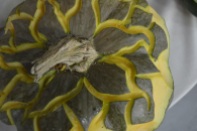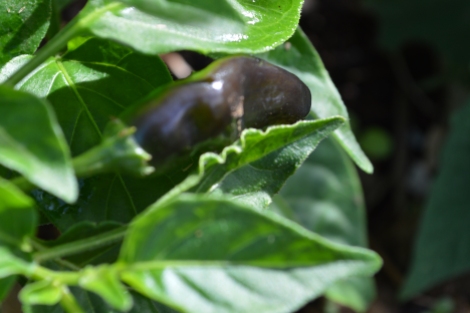I began fermenting back in July as a means of finding even more uses for the vegetables that I grow. In the past six months, I have continued to explore ways that fermentation can be good for me, my farm, other farmers, and the entire community. It continues to be a journey of discovering new things with each new ferment.
This past week I decided to continue to work with other farmers and their abundance. It turns out that my quarts of fermented produce have become a wonderful item to barter with. Squash is the core of all I do, so squash is also the core foundation of my fermentation. I have experimented with two varieties of winter squash, one variety of summer squash from my fellow farmer Lark, and pipinola. Pipinola is what I consider a cousin of squash. We have a unique name for it here in Hawaii, but it is more commonly known as chayote.
I have previously sung the wonders of pipinola on my webpage, but I would like to add that it is a good source of vitamin C. Raw chayote it crunchy, and crisp, which are two great things for fermentation. It is also quite neutral in flavor and color, making it my fill in for cabbage. It also releases water quite easily when salt is added.

I began my pipinola growing with green skinned heavily wrinkled fruits. I found a variation that I liked which was a smoother, softer skinned fruit. I selected these traits and gradually replanted the fruits that displayed this smooth skin. Like any variation there are upsides and downsides. The smoother, softer skin, makes the skin easily used in the kitchen instead of the tougher skinned ones. The downside, is that they are much more susceptible to damage through bruising and nicks. Pipinola/chayote is grown by replanting the fruits, and the one large seed within will germinate with a dynamic vine.
One you have your fermentation base vegetables, it is great to explore how new combinations can change it all up. So this week, I investigated how other farm goods can be brought into the mix. I have always loved root vegetables which are not easy to grow where I am farming. Beets have come into season again here in Hawaii, so it was time to revisit the Bonk family and get my hands on some beets. Marlene was happy to take a quart of pumpkin/carrot/pipinola kraut, while I was excited to fill my bag with beets.
With each new vegetable, I create a series of ferments that are linked by that one new flavor. If we were talking fashion design, my ferments would be a collection, so I will refer to them as such. In the beet collection, I decided to marry the sweet with the heat of ghost peppers in another, as featured above, I threw it all in.
Each of us will like different combinations of vegetables, and as is the case with fermentation, you may like some fermented vegetables, that you do not like unfermented. Fermentation transforms, melds, marries flavors into a complex profile. So with the new addition of beets, we can look at how they shape the ferment in terms of nutrition, flavor, and color. There is also the need to consider what is the limit of how much beet we can handle? When is it enough? Experiment so to know the limitations of your ferments. I love seaweed, known here as limu, but there is a point where enough is enough. To much limu can make the ferment very salty, and very intense in minerals. It can pack a punch and “kinda levels” those not used to it. I feel like beet could go the same route, in being an overpowering vegetable, where you need to understand how to use it as an accent, in a combination of flavors, and as a main flavor. As is the story of fermentation, time will tell. Longer fermentation time may make it mellow…or not.

Above, locally sourced Ogo seaweed is busy making my ferments both intense and complex.
Repurposing found objects is also a great way to begin in fermenting. I chose to repurpose a 4 qt crock pot crock and found a lid that would work with it. Most of my ferments are done in one quart jars, but I decided to try a larger quantity of the “kitchen sink” ferment. Quart jars were used for smaller volume experiments.
I’ll be keeping you posted on how the new farm ferment collection turns out, but until then, think in terms of abundance in your garden, your cellar, your farmers market, and region. Abundance is a luxury as long as you do not allow it to overwhelm you. Too much of a good thing can be stressful, and putting up a bushel of vegetables on your own, is quite a task. I can honestly tell you that it does get easier to work your way through a volume of produce. I think starting with what would roughly fit in a grocery bag is a good place to start. So give it a try…and good luck!




















































